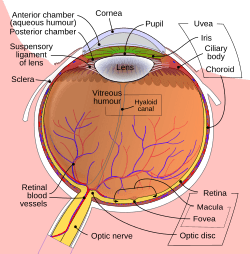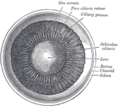Lens (eye) facts for kids
Quick facts for kids Crystalline lens (anatomy) |
|
|---|---|
 |
|
| Light from a single point of a distant object and light from a single point of a near object being brought to a focus by changing the curvature of the lens. | |
 |
|
| Schematic diagram of the human eye. | |
| Latin | lens crystallina |
| Gray's | subject #226 1019 |
| MeSH | Crystalline+lens |
The crystalline lens is a clear, curved part inside your eye. Think of it like a tiny, see-through camera lens. Along with the cornea (the front window of your eye), it helps to bend light. This bending makes sure the light focuses perfectly onto the retina at the back of your eye.
What's really cool is that the lens can change its shape! This change helps your eye focus on things whether they are far away or very close. This special ability is called accommodation. It's a bit like how a camera adjusts its lenses to get a clear picture. The lens is a bit flatter on the side facing the front of your eye.
Sometimes, the lens is also called the aquula or crystalline lens. In humans, this lens does about one-third of the work to focus light. It has a focusing power of around 18 dioptres.
Contents
How the Lens Is Built
The lens is located in the front part of your eye. Right in front of it is the iris. The iris is the colored part of your eye that controls how much light gets in. The lens is held in place by tiny threads called the suspensory ligament. These threads connect the lens to a muscle called the ciliary body.
Behind the lens is a jelly-like substance called the vitreous body. In front, there's a watery fluid called the aqueous humor. Both of these fluids surround and protect the lens. The lens has a curved shape on both sides, like a small, clear bean. The front surface is a little less curved than the back. In adults, the lens is usually about 10 millimeters wide and 4 millimeters thick. But remember, it can change shape when you focus, and it keeps growing throughout your life!
What the Lens Is Made Of
The lens has three main parts. These are the lens capsule, the lens epithelium, and the lens fibers. The lens capsule is the outside layer, like a clear skin. The lens fibers make up most of the inside of the lens. The lens epithelium is a layer of cells found only on the front side, between the capsule and the fibers. It's important to know that the lens does not have nerves, blood vessels, or connective tissue.
The Lens Capsule
The lens capsule is a smooth, clear membrane that completely covers the lens. It's very stretchy and is made of a protein called collagen. This capsule is made by the lens epithelium cells. Because it's so elastic, the lens can become more rounded when the tiny threads (zonular fibers) that hold it are relaxed. The capsule's thickness varies, being thickest near the middle edges and thinnest at the back.
The Lens Epithelium
The lens epithelium is a layer of cells on the front part of the lens. These cells are like small cubes. They control most of the important jobs that keep the lens healthy. For example, they help move water and nutrients into and out of the lens. This keeps the lens at the right balance of water and other substances.
These special cells also create new lens fibers. They keep adding new fibers throughout a person's entire life. This means your lens is always growing, even when you're an adult!
The Lens Fibers
The lens fibers make up most of the lens. They are long, thin, and clear cells. They are packed very tightly together. Each fiber is usually about 4 to 7 micrometers wide and can be up to 12 millimeters long. These fibers stretch from the back to the front of the lens. If you could cut the lens horizontally, you would see them arranged in layers, like an onion. If you cut it along the middle, it would look like a honeycomb.
The lens is divided into different areas based on how old the lens fibers are. The oldest fibers are in the very center, forming the "embryonic nucleus." Around that are the "fetal nucleus" and then the "adult nucleus." The newest fibers are added to the outer layer, called the "cortex." Once lens fibers are mature, they don't have the usual cell parts like organelles or nuclei.
Related pages
Images for kids
See also
 In Spanish: Cristalino para niños
In Spanish: Cristalino para niños







